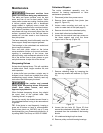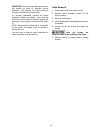
18
45 degree forward stop:
1. The 45 degree forward stop is controlled by
the screw (E, Figure 25).
2. Loosen the locking handle (B, Figure 25)
and the hex nut on the screw (E, Figure 25).
3. Set the 45 degree protractor on the table
and against the fence, and tilt the fence until
it is flush against the 45 degree angle.
4. Rotate the screw (E, Figure 25) until it
contacts the casting below it.
5. Tighten hex nut (E, Figure 25) and locking
handle (B, Figure 25).
45 degree back stop:
1. Flip the stop block (C, Figure 25) out of the
way.
2. The 45 degree back stop is controlled by the
screw (F, Figure 25).
3. Loosen the locking handle (B, Figure 25)
and the hex nut on the screw (F, Figure 25).
4. Use a protractor set at 45 degrees beyond
the right angle (a total of 135 degrees) and
place it on the table and against the fence.
Tilt the fence until it is flush with the
protractor.
5. Rotate the screw (F, Figure 25) to the
proper height.
6. Tighten hex nut (F, Figure 25) and locking
handle (B, Figure 25).
Basic Jointer Operation
NOTE: If you are inexperienced at jointing, use
scrap pieces of lumber to check settings and get
the feel of operations before attempting regular
work.
This section briefly discusses general rules as
well as some of the basic cuts using a jointer,
such as surfacing, edging, beveling, skewing,
rabbeting and taper cuts.
Always use cutterhead guard
(except during rabbeting) and keep hands
away from cutterhead.
Jointing Short or Thin Work
When jointing short or thin pieces, use a push
pad or push block to eliminate all danger to the
hands. Two push pads are included with your
jointer. You can also make your own push block
from scrap material. Three types are illustrated
in Figure 26.
Figure 25 (repeated)
Figure 26


















